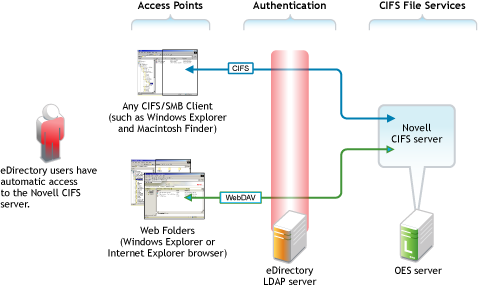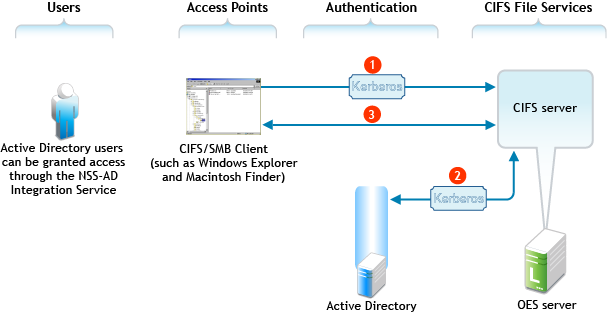16.1 Overview of File Services
The file service components in OES include the following:
-
FTP Services: Lets users securely transfer files to and from OES servers.
-
NetWare Core Protocol: Provides NetWare Core Protocol (NCP) access to NCP volumes (including NSS volumes) that you define on OES server partitions.
-
CIFS: Provides native Windows (CIFS and HTTP-WebDAV) access to files stored on an NSS volume on an OES server.
16.1.1 Using the File Services Overviews
Each graphical overview in the following sections introduces one of the OES file service components. If visual presentations help you grasp basic concepts, continue with the following overviews. If you prefer to skip the overviews, go to Section 16.2, Planning for File Services.
16.1.2 FTP Services
OES offers a level of integration between eDirectory and Pure-FTP that allows users to authenticate to eDirectory for FTP access to the server. You simply select the OES FTP Server pattern in the OES installation, then make sure the users needing access are LUM-enabled and have access rights to the areas on the server they need to use. You can also migrate an existing FTP server configuration from a NetWare server to OES. For migration instructions and a brief FAQ, see Migrating FTP to OES 2023
in the OES 2023: Migration Tool Administration Guide.
For documentation on Pure-FTP, visit the Pure-FTP Web site.
16.1.3 NetWare Core Protocol
NetWare Core Protocol (NCP) is the technology beneath many of the network services for which NetWare is famous.
In OES, NCP is also available on Linux. The OES NCP Server for Linux provides the rich file services that Novell is known for. Windows users who run Client for Open Enterprise Server software can access data, manage files and folders, map drives and so on, using the same methods as they do on NetWare servers.
Figure 16-1 illustrates the basics of NCP file services. For more information on how NCP can help you manage access to network resources, see Access Control and Authentication.
Figure 16-1 NCP Services for Linux and NetWare

The following table explains the information illustrated in Figure 16-1.
Table 16-1 NCP Access
|
Access Methods |
Authentication |
NCP Services |
|---|---|---|
|
Access is through an NCP client—specifically, the Client for Open Enterprise Server. |
All file service access is controlled by eDirectory authentication. |
Files are stored on NetWare or NCP volumes that the administrator has created. The same core set of NetWare file attributes are available on both Linux and NetWare. |
16.1.4 CIFS
The CIFS service lets users on Windows workstations access and store files on OES servers with NSS volumes without installing any additional software, such as the Client for Open Enterprise Server.
Figure 16-2 How Novell CIFS Works for eDirectory Users

Table 16-2 CIFS Access for eDirectory Users
|
Access Methods |
Authentication |
|---|---|
|
eDirectory users on Windows workstations have two native Windows file access options:
|
All file service access is controlled by LDAP-based authentication through the eDirectory server. |
Figure 16-3 How CIFS Works for Active Directory Users

Table 16-3 CIFS Access for Active Directory Users
|
Access Methods |
Authentication |
|---|---|
|
Active Directory users gain access to CIFS file services as follows:
|
All CIFS file service access is controlled by Kerberos-based authentication and Active Directory. |